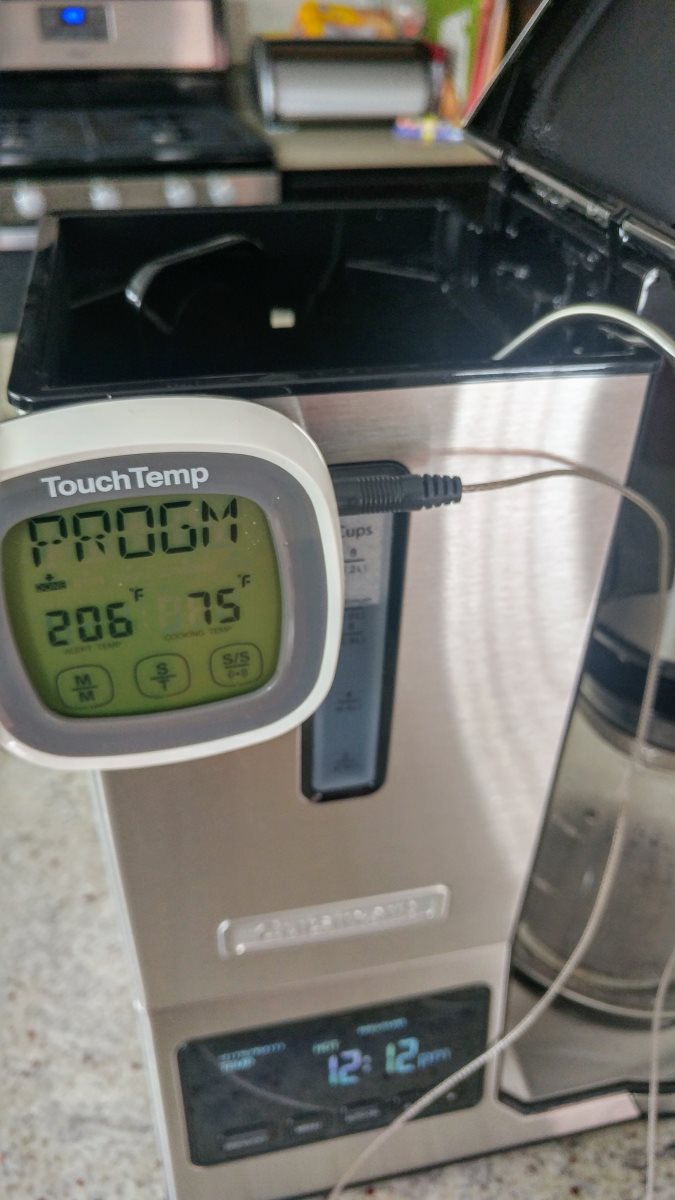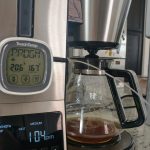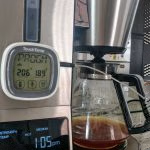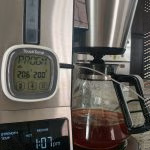This is part of my Everyday Coffee series, in which I review four affordable SCAA-certified coffeemakers. Read on to find out how the Cuisinart CPO-800 ranks after a week of “daily driver” use!
A Week with the Cuisinart CPO-800

In my last post, I introduced you to the Cuisinart CPO-800. Over the past week, I’ve been using it as my daily driver for coffee. Today I’m going to post my results.
Since this series is titled “everyday coffee”, I’m going to skip over technical measurements like acidity and total dissolved solids. Instead, I’m going to focus on subjective, real-world measurements like taste, ease of use, and overall functionality. The idea here is that this has to fit into real life for everyday people; great coffee and minimal hassle are absolute “must haves”, especially at this price range.
My cost for the CPO-800 unit was $179.99 plus tax from Kohl’s. That makes this tied with the Bunn HB for the most expensive coffeemaker in this series. And unfortunately, it’s just not worth it.
So How Does it Taste?
My brews through the Cuisinart CPO-800 were, put simply, not good. The coffee tasted muted and had a significant sour undertone. I was using the manual’s recommended settings — medium brew, hot temperature — as well as the “golden ratio” of 55 grams of beans per liter of water.
The delicate notes of the Ethiopia Sidamo from Little Amps failed to materialize, and the French Roast came out severely underpowered. I tried adjusting my grind size and even switched to a paper filter, to no avail.
I was able to mitigate this somewhat by changing to “bold”, which produced a vastly more drinkable cup. With “bold” enabled, the French Roast was acceptable, but the CPO-800 consistently failed to deliver on the Sidamo.

Adding insult to injury, the permanent filter isn’t very good. Every pot had sludge in the bottom unless I used the maximum coarse setting on my burr grinder. If you recall from my first review, this was a concern I had from the moment I opened the box. Fortunately, the Cuisinart CPO-800 uses a #4 cone filter, which you can find at any supermarket. With the paper filter in place, there was no sludge to be found.
I found The PRoblem

You’re a smart, educated coffee consumer, so you already know that coffee needs to be brewed somewhere between 195 and 205 degrees. The exact temperature is subject to taste and quality of the grounds, but when coffee tastes dull or underpowered, it’s almost always because of bad beans or low water temperature.
I whipped up a manual pourover as control against bad beans. It was perfect; those subtle flavors came through loud and clear. The beans weren’t the problem.
I started with room-temperature water. All of my tests use water between 70 – 75 degrees. While it’s possible that this five-degree variance could impact the final brew temperature, that would be a significant failure on the part of the coffeemaker.
While the CPO-800 does indeed reach the recommended 195-205 brewing range, it doesn’t do it immediately. The presoak cycle peaked at 167 degrees — far too low. The brew cycle ranged from 189 – 200 degrees. In fact, it took about two cups for the temperature to reach 195 degrees.
That’s 25% of the pot filled with substandard, under-brewed coffee. Every single time.
In simple English, the Cuisinart CPO-800 doesn’t get hot enough to extract the full flavor from the coffee grounds until it’s already about a fourth of the way through the brew cycle.
This may be due in part to the Cuisinart CPO-800’s lack of a preheat cycle. Instead of heating the water in the reservoir, Cuisinart starts brewing almost immediately. The water is heated as it passes through to the brew chamber. Apparently, this is insufficient to heat the water quickly enough.
Everything Else You Need To Know
All the heavy-use components of the CPO-800 — the carafe, the carafe lid, the brew basket, and the permanent filter — are top-rack dishwasher safe. Yeah, I know: you should always hand-clean everything using nothing but pixie dust, subatomic-filtered air, and artisan handcrafted sponges. And while you’re doing that, the rest of us have a life to live. Into the dishwasher it goes.
Power usage is about half a watt while idle. The brew cycle draws about 1300 – 1450 watts, while the keep-warm phase draws about 110 watts. This is slightly higher power usage than the other coffeemakers I tested, though perfectly acceptable for a high-end consumer unit.
None of the test units were particularly loud, but the CPO-800 was easily the quietest. Aside from a quiet rumble from the heater and some end-of-cycle gurgling, it may be the quietest automatic coffeemaker I’ve ever tested.

The display is simply beautiful. VFD has long been surpassed by newer, more energy-efficient technologies, but you can’t beat the soft, easy-to-read look. It’s dark enough to not be obnoxious at night and bright enough to read in direct sunlight.
The overall appearance of the unit is perfect. It stands out, but not in an obnoxious way. The 80s styling cues are definitely a welcome change from the current batch of cookie-cutter home appliances. Unfortunately, none of these bonuses are enough to overcome the substandard coffee that results.
The Final Verdict
The design is stunning. The display is beautiful. The well-sealed top keeps your kitchen cabinets safe.
Unfortunately, it’s just not up to par with the rest of the group. This actually performs worse than my six-year-old, non-SCAA-certified, battle-tested Cuisinart DGB-550BK.
The Cuisinart CPO-800 is not a good coffeemaker. It gets outperformed by my old off-the-shelf automatic drip, and in no way justifies its high price. Fortunately, I’ve got three more SCAA-certified coffeemakers to test as part of my Everyday Coffee series. Check back in a few days for the next batch!





